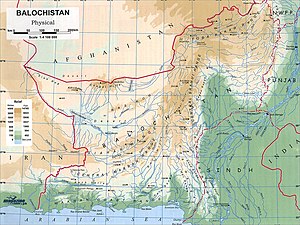Etymology of Baluchestan (Iran/Pakistan)


The Baloch people once referred to their land as Moka or Maka, a word which later became Makran. Moka might have been an adaptation of Mahi-khoran, Persian for "Fish-Eaters", an appellation used by the Persians of the west for the people of coastal Perso-Pak region of Balochistan province. Arrian, in his Anabasis Alexandri, referred to the people of the region as the Ichythophagi, a Greek translation of Mahi-khoran. Balochistan is referred to in Pashto as Gwadar or Godar (also Godar-khwa, i.e., The Land by the Water “Arabian Sea”). The Ancient Greeks, who derived the names of Iranian lands from the Bactrian language, Hellenised it to Gedrosia. During the time of Alexander the Great (356–323 BCE), the Greeks called the land Gedrosia and its people Gedrosoi, terms of unknown origin.[1] Using etymological reasoning, H. W. Bailey reconstructs a possible Iranian name, Uadravati, meaning "the land of underground channels", which could have been transformed to Badlaut in the 9th century and further to Balōč in later times. This reasoning remains speculative.[2]
In an 11th-century Sanskrit compilation of Jataka tales (Avadānakalpalatā) by Kshemendra of Kashmir, the land is called Baloksh (बलोक्ष). From Baloksh, the name evolved and was Persianised to Balochistan. The area is named after the numerous Baloch (or Baluch, Balouch, Balooch, Balush, Balosh, Baloosh, Baloush) tribes, an Iranian people, who moved into the area Since the Baloch people are not mentioned in pre-Islamic sources, it is likely that the Baloch were known by some other name in their place of origin and that they acquired the name "Baloch" only after arriving in Balochistan sometime from the west from Syriac Kurdistan around 1000 A.D in the late 10th century.[3] All natives are considered Balochi even if they do not speak Balochi; Pashto, Persian, and Brahui languages are also spoken in the region. The southern part of Balochistan is known as “Makran” in the Persian plateau. There are also relatively smaller communities of Iranian Baloch, Hazaras, Sindhis and other settlers, including Punjabis, Uzbeks, and Turkmens. The name Balochistan means "The Land of the Baloch" in many regional languages of Pakistan respectively. Although during the Stone and Bronze Age and Alexander the Great's Empire an indigenous population existed, the Baloch people themselves did not enter the region until the 14th century CE.[4] A theory of the origin of the Baloch people, the largest ethnic group in the region, is that they are of Median descent.[5]
Johan Hansman relates the term "Baloch" to Meluḫḫa, the name by which the Indus Valley civilisation is believed to have been known to the Sumerians (2900–2350 BCE) and Akkadians (2334–2154 BCE) in Mesopotamia.[6] Meluḫḫa disappears from the Mesopotamian records at the beginning of the second millennium BCE.[7] However, Hansman states that a trace of it in a modified form, as Baluḫḫu, was retained in the names of products imported by the Neo-Assyrian Empire (911–605 BCE).[8] Al-Muqaddasī, who visited the capital of Makran, Bannajbur, wrote c. 985 CE that it was populated by people called Balūṣī (Baluchi), leading Hansman to postulate "Baluch" as a modification of Meluḫḫa and Baluḫḫu.[9]
Asko Parpola relates the name Meluḫḫa to Indo-Aryan words Mleccha (Sanskrit) and milakkha/milakkhu (Pali) etc., which do not have an Indo-European etymology even though they were used to refer to Non-Aryan people. Taking them to be proto-Dravidian in origin, he interprets the term as meaning either a proper name Milu-Akam (from which Tamilakam was derived when the Indus people migrated south) or Melu-Akam, meaning "High Country", a possible reference to Balochistani high lands.[10] Historian Romila Thapar also interprets Meluḫḫa as a proto-Dravidian term, possibly Mēlukku, and suggests the meaning "western extremity" (of the Dravidian-speaking regions in the Indian subcontinent). A literal translation into Sanskrit, Aparānta, was later used to describe the region by the Indo-Aryans.[11]



See also[edit]
References[edit]
- ↑ Bevan, Edwyn Robert (12 November 2015), The House of Seleucus, Cambridge University Press, p. 272, ISBN 978-1-108-08275-4
- ↑ Hansman 1973
- ↑ Elfenbein, J. (1988), "Baluchistan iii. Baluchi Language and Literature", Encyclopaedia Iranica
- ↑ "Balochistan | province, Pakistan | Britannica". www.britannica.com. Retrieved 2023-02-15.
- ↑ M. Longworth Dames, Balochi Folklore, Folklore, Vol. 13, No. 3 (29 September 1902), pp. 252–274
- ↑ Parpola 2015, Ch. 17: "The identification of Meluhha with the Greater Indus Valley is now almost universally accepted."
- ↑ Hansman 1973, p. 564.
- ↑ Hansman 1973, p. 565.
- ↑ Hansman 1973, pp. 568–569.
- ↑ Parpola & Parpola 1975, pp. 217–220.
- ↑ Thapar 1975, p. 10.
